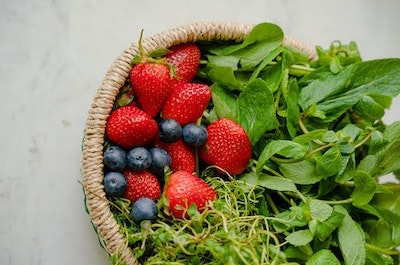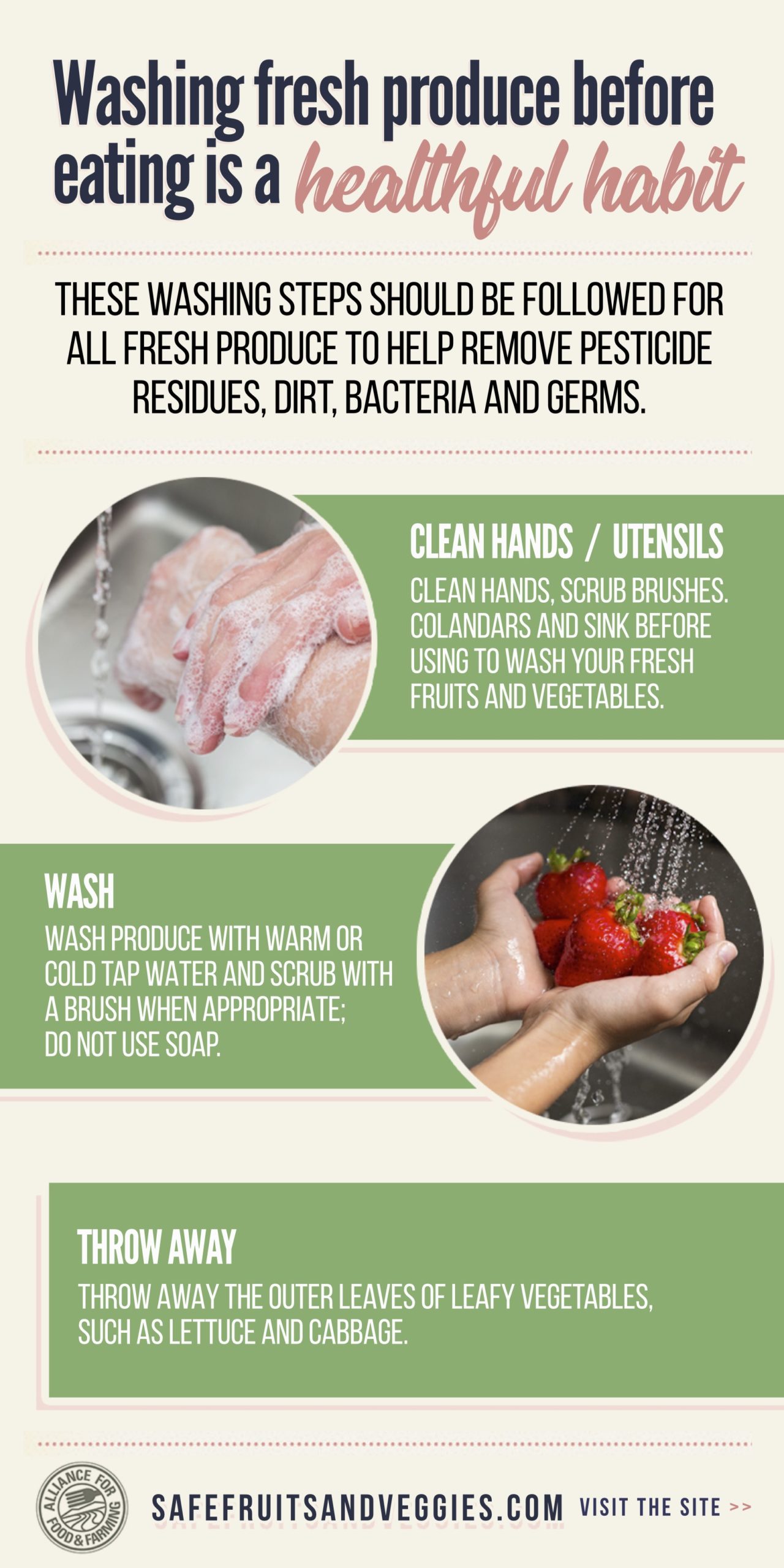 Spring is here! The images of farmers’ markets and planting our own backyard or container gardens dance in our minds with delight … especially for those of us dealing with a long winter. Fruits and vegetables suddenly have a broader appeal when we see those first asparagus spears poke their heads above the soil; when we pick the first fresh kale or lettuce leaves; or when we savor those “fresh from the patch” strawberries. But no good deal or thought goes without an opposing view! Soon, a “Dirty Dozen” list will advise us to banish 12 fruits or vegetables based on “calculated” pesticide residues. This list is not founded on sound facts. It’s time to ditch the fear. Regardless of how they are grown, all fruits and vegetables are safe and healthful!
Spring is here! The images of farmers’ markets and planting our own backyard or container gardens dance in our minds with delight … especially for those of us dealing with a long winter. Fruits and vegetables suddenly have a broader appeal when we see those first asparagus spears poke their heads above the soil; when we pick the first fresh kale or lettuce leaves; or when we savor those “fresh from the patch” strawberries. But no good deal or thought goes without an opposing view! Soon, a “Dirty Dozen” list will advise us to banish 12 fruits or vegetables based on “calculated” pesticide residues. This list is not founded on sound facts. It’s time to ditch the fear. Regardless of how they are grown, all fruits and vegetables are safe and healthful!
Face the Facts
Let’s first face the basic reality: we don’t eat enough fruits and vegetables. According to the Produce for Better Health’s “State of the Plate: American’s Fruit & Vegetable Consumption Trends,” our consumption patterns are less than stellar. Here are the facts:1
- Most of us (9 of 10) only eat ONE serving of fruits and vegetables daily! (Goal: 4-5 cups/servings daily)
- Our fruit and veggie intake has decreased about 10% since 2004, when the “State of the Plate” research began, despite efforts to communicate the positive benefits.
- The health benefits of daily consumption of fruits and vegetables is well grounded. Strong science suggests that eating fruits and vegetables may reduce our risk for multiple health conditions, including heart disease and certain forms of cancer and obesity, as well as improve our mental and cognitive status.
When we don’t even eat enough fruits and vegetables, why is there a need to create fear that is unnecessary?
Breaking Down the “List”
For the past 27 years, a U.S. based environmental advocacy group, the Environmental Working Group (EWG), has created an annual list of conventionally grown fruits and vegetables known as the “Dirty Dozen” — so noted since they are suspected of having the greatest potential for contamination from residues of pesticides. EWG recommends buying the organic form of these foods to be safer. But here are the realties: (1) organic is not pesticide free and (2) the group’s methodology is not based on actual consumer exposure (consumption).
 For example, Jennifer Schmidt, MS, RD, farm owner and certified pesticide applicator, states, “Pesticides can be either organic or synthetic but they both serve the same purpose, to kill pests. Each chemical is labeled for its toxicity level and it’s impacts on humans, animals, the environment. Some organic products are more toxic than their synthetic counterparts and vice versa. For the consumer to believe that because something is labeled organic does not mean it wasn’t sprayed with pesticides or that the pesticides used are “safer.” Jennifer raises organic and conventional crops and it’s always about the dose or level regardless of the type of pesticide. Hence the issues with the method used to develop the list.
For example, Jennifer Schmidt, MS, RD, farm owner and certified pesticide applicator, states, “Pesticides can be either organic or synthetic but they both serve the same purpose, to kill pests. Each chemical is labeled for its toxicity level and it’s impacts on humans, animals, the environment. Some organic products are more toxic than their synthetic counterparts and vice versa. For the consumer to believe that because something is labeled organic does not mean it wasn’t sprayed with pesticides or that the pesticides used are “safer.” Jennifer raises organic and conventional crops and it’s always about the dose or level regardless of the type of pesticide. Hence the issues with the method used to develop the list.
Over the past couple of decades, toxicologists at the University of California-Davis have conducted studies to evaluate if the levels of pesticides for the frequently cited produce are a potential consumer risk. The answer is NO! Here’s the facts:2
1. The research evaluated the 10 most frequently identified pesticide residues on the identified produce and found all estimates significantly below the USDA Pesticide Data Program established safe reference doses. In fact, over 75% of the pesticide/produce tested revealed exposure estimates below 0.01% of the USDA references or one million times below chronic No Observable Adverse Effect Levels from animal toxicology studies.2 The USDA’s Pesticide Data Program, in existence since 1991, is designed to continually measure pesticide residues on food to ensure foods are safe to eat by any age group — especially children — over a long period of time.3
2. Research shows the EWG’s recommendations to substitute organic for conventionally grown does not reduce the risk because residues are very low on conventional, if at all.
3. The UC-Davis toxicologists found that the level of residues, if present at all, were so low that any of us — child or adult — could eat hundreds to thousands of servings of fruits or vegetables in a day and still not have any health effects due to residues.
Putting Residue Risk in Perspective
Using the pesticide residue calculator at safefruitsandveggies.com, let’s look at two examples of produce I frequently eat: blueberries and kale.

When it comes to kale, I could consume 18,611 servings of kale in one day without any effect even if the kale had the highest pesticide level. And I like kale, but one to two times weekly is enough. These look like ridiculous numbers, and they are! But it shows that worrying about pesticide residues on produce is not the main issue. In fact, government sampling conducted by U.S. Department of Agriculture (USDA) consistently shows that over 99% of residues found on foods were well below safety levels established by the Environmental Protection Agency and one-third had no detectable residues at all.3

Whether we buy local, organic or conventionally grown produce, the potential concern of any residue can be easily washed away. The best advice is to follow the FDA Guide on washing produce:3
1. Wash all produce thoroughly under running water before preparing and/or eating. This includes produce grown at home or bought from a grocery store or farmers’ market, and both organic and conventional. DO NOT USE SOAP OR DETERGENT.
2. Even if the skin is not consumed, like on a melon, it is still important to wash produce first so dirt and bacteria are not transferred from the surface when peeling or cutting produce. Food borne illness cases have occurred over the years when cantaloupes were consumed without washing them. Make sure firm produce, like melons, are cleaned with a vegetable brush.
3. Remove and discard the outer leaves of leafy vegetables, like lettuce and cabbage, and cut away any damaged or bruised areas on fresh fruits and vegetables before preparing and/or eating.
4. Finally, always start with clean hands and clean utensils.
The Bottom Line
Eating MORE fruits and vegetables is the goal regardless of whether you choose conventionally grown or organic. The benefit of eating more outweighs any potential concern regarding pesticide residues. It’s time to ditch the fears and focus on the facts!
References:
1. “2020 State of The Plate Executive Summary,” Produce for Better Health Foundation.
2. “Dietary exposure to pesticide residues from commodities alleged to contain the highest contamination levels,” by C.K. Winter and J.M. Katz, Journal of Toxicology, 2011.
3. “Washing Fresh Produce – Do‘s and Don’ts,” Alliance for Food and Farming, March 29, 2022.
